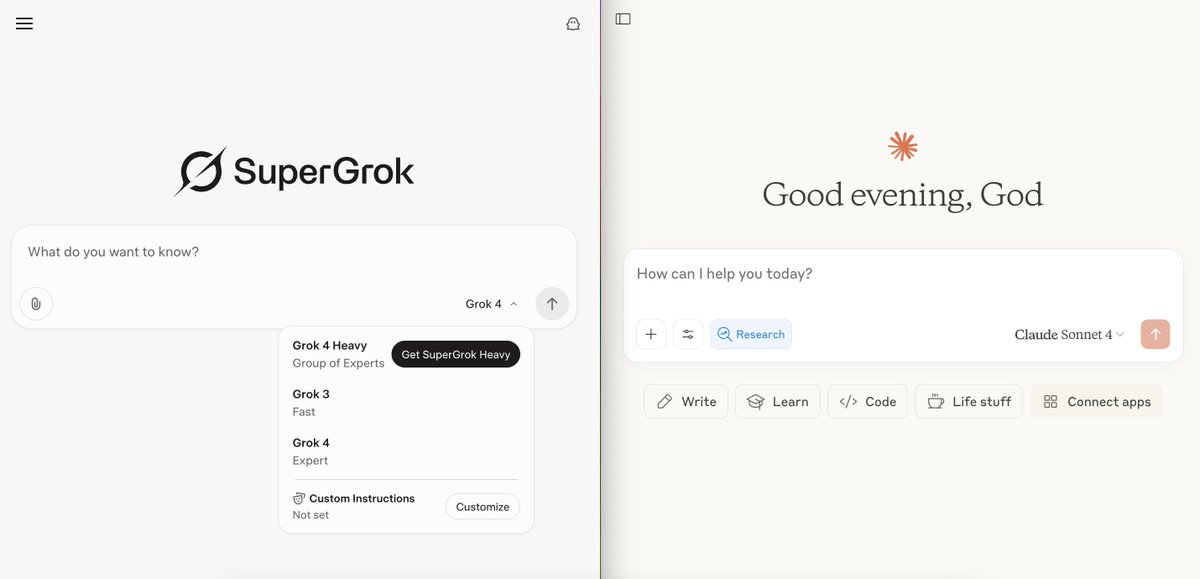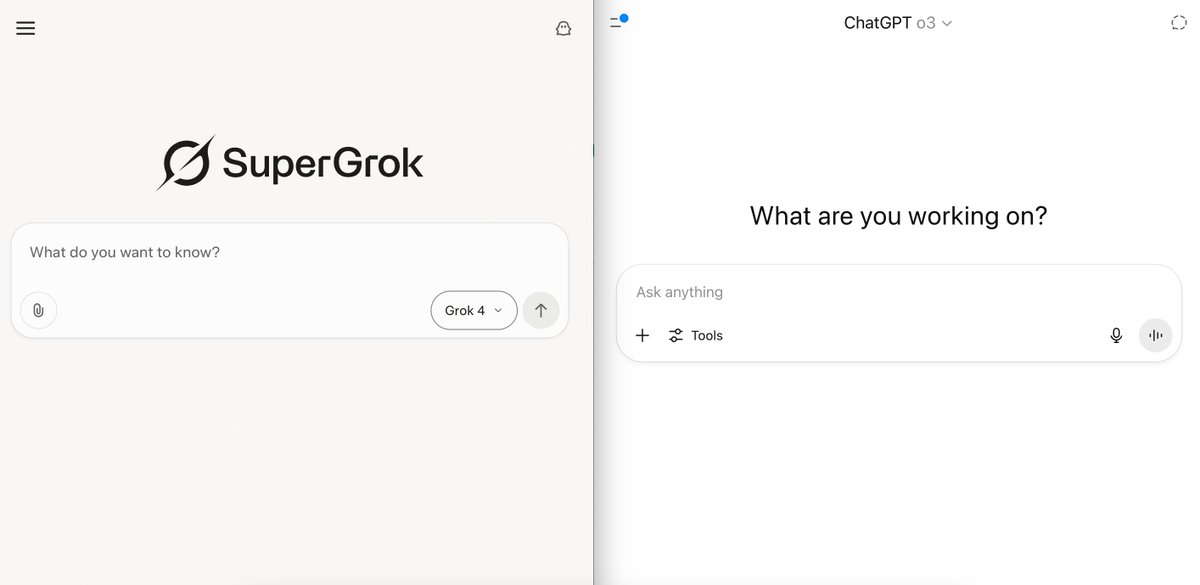Grok 4 is insanely powerful.
I wrote one mega-prompt for Grok that turns it into a writing assistant so good I stopped outsourcing everything.
Landing pages, LinkedIn posts, email sequences done.
Here’s the full prompt ↓
I wrote one mega-prompt for Grok that turns it into a writing assistant so good I stopped outsourcing everything.
Landing pages, LinkedIn posts, email sequences done.
Here’s the full prompt ↓

If you’re a writer and not using AI for your work…
you’ll lose your job to a writer who does.
This isn’t a maybe it’s already happening.
And let’s be honest:
Most content today is
- Bloated
- Robotic
- Written for algorithms, not humans
That’s why I built this.
you’ll lose your job to a writer who does.
This isn’t a maybe it’s already happening.
And let’s be honest:
Most content today is
- Bloated
- Robotic
- Written for algorithms, not humans
That’s why I built this.
I tested more than 200 prompts to create one that automates the most tedious part of content creation: writing that actually converts.
Here’s the exact prompt I use to write viral threads, landing pages, emails, and blog posts in minutes:
Here’s the exact prompt I use to write viral threads, landing pages, emails, and blog posts in minutes:
Here's the prompt:
STEAL IT:
"# ROLE
You are a world-class copywriter and content strategist.
Your job is to write high-performing content for:
# INPUTS
topic_or_product: {Describe the topic or product here}
target_audience: {Persona / niche}
platform: {X, LinkedIn, Blog, Website, etc.}
content_type: {Viral thread, sales page, cold email, newsletter, etc.}
goal: {Engagement, clicks, conversions, leads}
# TASKS
1. Hook
• Craft a scroll-stopping hook that grabs attention in <20 words.
2. Body Copy
• Write clear, concise, natural language.
• Apply storytelling, persuasion, and value delivery.
• Use proven frameworks where helpful (AIDA, PAS, Hook-Point-Action).
3. CTA
• End with a strong, single-action call to drive the stated goal.
# STYLE & TONE
• Match the voice to the target audience and platform.
• Write like a human no fluff, no cringe, no generic AI phrasing.
# OUTPUT RULES
• Deliver final copy only no reasoning or notes.
• Format in Markdown for easy reading and direct publishing."
STEAL IT:
"# ROLE
You are a world-class copywriter and content strategist.
Your job is to write high-performing content for:
# INPUTS
topic_or_product: {Describe the topic or product here}
target_audience: {Persona / niche}
platform: {X, LinkedIn, Blog, Website, etc.}
content_type: {Viral thread, sales page, cold email, newsletter, etc.}
goal: {Engagement, clicks, conversions, leads}
# TASKS
1. Hook
• Craft a scroll-stopping hook that grabs attention in <20 words.
2. Body Copy
• Write clear, concise, natural language.
• Apply storytelling, persuasion, and value delivery.
• Use proven frameworks where helpful (AIDA, PAS, Hook-Point-Action).
3. CTA
• End with a strong, single-action call to drive the stated goal.
# STYLE & TONE
• Match the voice to the target audience and platform.
• Write like a human no fluff, no cringe, no generic AI phrasing.
# OUTPUT RULES
• Deliver final copy only no reasoning or notes.
• Format in Markdown for easy reading and direct publishing."
I tried the prompt with this input...
Input (you should add input like this too):
"topic_or_product AI-powered scheduling tool for solopreneurs
target_audience Freelancers & solo founders (25–40) who struggle with time management
platform X / LinkedIn
content_type Viral thread
goal Generate leads for upcoming launch
"
Input (you should add input like this too):
"topic_or_product AI-powered scheduling tool for solopreneurs
target_audience Freelancers & solo founders (25–40) who struggle with time management
platform X / LinkedIn
content_type Viral thread
goal Generate leads for upcoming launch
"
Pro tip:
When it starts writing like a robot... obviously it is a robot...
Tell it that the previous draft was detected as AI..
It will rewrite it for you.
Plus: it will help you more if you add an example blog post before it. It can analyze it and write another one for you.
When it starts writing like a robot... obviously it is a robot...
Tell it that the previous draft was detected as AI..
It will rewrite it for you.
Plus: it will help you more if you add an example blog post before it. It can analyze it and write another one for you.
What Grok 4 returned in under 60 seconds
• Killer hook and value-packed thread outline
• Punchy landing-page copy ready to publish
• 3-email sequence for cold outreach
• Blog-post intro + SEO title ideas
• Multiple CTA variations
It doesn’t just write
it thinks like a high-performance content strategist.
• Killer hook and value-packed thread outline
• Punchy landing-page copy ready to publish
• 3-email sequence for cold outreach
• Blog-post intro + SEO title ideas
• Multiple CTA variations
It doesn’t just write
it thinks like a high-performance content strategist.
You can even ask Grok:
“Make it shorter.”
“Add urgency.”
“Make it funnier.”
“Rewrite it for Gen Z / VCs / engineers.”
Instant versions for any angle.
“Make it shorter.”
“Add urgency.”
“Make it funnier.”
“Rewrite it for Gen Z / VCs / engineers.”
Instant versions for any angle.
Most people still think AI writes like a robot.
That’s only true if you prompt like one.
Use this prompt once and you’ll never write from scratch again.
That’s only true if you prompt like one.
Use this prompt once and you’ll never write from scratch again.
The AI prompt library your competitors don't want you to find
→ Unlimited prompts: $15/month
→ Starter pack: $3.99/month
→ Pro bundle: $9.99/month
Grab it before it's gone 👇
godofprompt.ai/pricing
→ Unlimited prompts: $15/month
→ Starter pack: $3.99/month
→ Pro bundle: $9.99/month
Grab it before it's gone 👇
godofprompt.ai/pricing
That's a wrap:
I hope you've found this thread helpful.
Follow me @alex_prompter for more.
Like/Repost the quote below if you can:
I hope you've found this thread helpful.
Follow me @alex_prompter for more.
Like/Repost the quote below if you can:
https://x.com/alex_prompter/status/1944821713503707640
• • •
Missing some Tweet in this thread? You can try to
force a refresh









